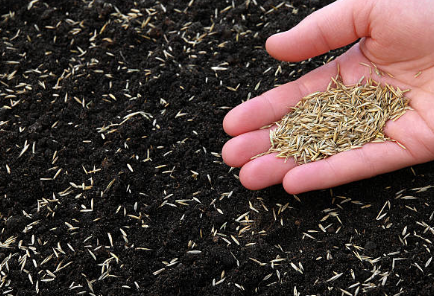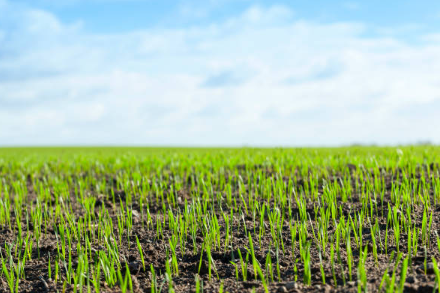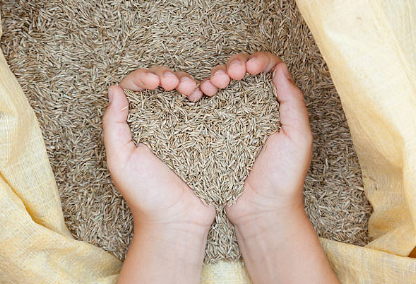
Grass seed comes from stems of grass that have not been mowed and are allowed to grow tall. In order to allow for pollination, the seed heads, or “inflorescences,” emerge, stick out, and then retract into dormancy. When the seed hardens or reaches maturity, it is ready to be harvested. Continue reading, you will learn more about grass seeds come from.
Table of Contents
What is Grass Seed?
There are thousands of different species of grass, each with its own unique traits and life cycle, though the exact number is unknown.
Grass stems that haven’t been mowed and are allowed to grow tall are what produce grass seed. The seed heads, known as ‘inflorescences’ emerge and stick out to allow for pollination and then recede into dormancy. When the seed hardens or reaches maturity, it is then ready to be harvested.
Does Grass Seed Itself?
It’s unlikely that your lawn will self-seed if you mow it frequently. The inflorescence, which produces grass seeds once the grass blade reaches a certain size, is a group of flowers.
The seeds are fertile and prepared to develop into new, fresh grass stems because these inflorescent clusters typically contain both male and female components. A process known as apomixis allows some grass species to reproduce without fertilization by creating clones of the parent plant from the seed.
In either case, just keep mowing to stop flowers from growing and producing seeds if you don’t want your lawn to spread. If you keep your lawn short, it will never have a chance to develop into a self-seeding lawn.
Why then, when it’s kept short and there aren’t any flowers in sight, have you noticed the grass spreading? This is so that grass species can spread through rhizomes, which are underground stems. These rhizomes can produce fresh grass shoots, effectively expanding the surface area covered in grass.
If not controlled, the new grass will create its own inflorescent clusters and seeds. A lawn’s ability to spread through rhizomes can once again be stopped by routine mowing. Additionally, in dry conditions, this is less likely to occur. However, to encourage this natural growth, keep your lawn well-watered if you want it to spread.
Where Does Ryegrass Seed Come From?
Perennial ryegrass is a species of grass that is frequently used all over the United States. The perennial ryegrass family’s fine-bladed grasses are renowned for their quick germination and establishment rates. In both permanent northern and southern lawns, the brief winter color is a prized element. Your immediate lawn goals may be met by perennial ryegrasses. Perennial ryegrass and seed heads are generally not problematic at lower mowing heights.

Ryegrass develops quickly. After 3 days of planting, you can usually see the seeds sprouting, and after 21 days, you can mow your lawn. In temperate Eurasia and Africa, ryegrass—a member of the Poaceae family—is grown for forage and as a lawn grass. A variety of domestic and agricultural uses exist for ryegrass. It could result in a high forage yield. Additionally, it provides forage-eating animals with excellent nutrition.
Despite having a similar appearance, annual ryegrass (also known as Italian ryegrass) and perennial ryegrass are two distinct species.
Ryegrass is a bunch of grass with a shallow root system, unlike Kentucky bluegrass, which forms rhizomes. You must plant, fertilize, and irrigate at the appropriate times and in the right amounts if you plan to seed, establish, and manage ryegrass. The importance of starting with top-notch perennial ryegrass seed cannot be overstated. Attempt to use organic fertilizers with a lot of nitrogen. The initiation and induction growing points occur in ryegrass seeds just like they do in the seeds of other cool-season grasses. From early March until the end of September, seeds use their underground environment to gather and develop energy.
What Are the Signs You Need Grass Seed?
Grass seed is a much more cost-effective option than installing turf when creating a brand-new lawn. You should definitely add some grass seed if your lawn is uneven or has dead patches. The process of adding grass seed to an existing lawn is called ‘overseeding’.
How Does Overseeding Work?
Grass seeds must go through germination after being sown in the ground. During this process, the seeds hold onto enough water to begin sprouting grass blades. The germination process can be aided or impeded by a variety of factors. Some of these factors include:
- Soil temperature – The soil needs to be around 12°C in order for spring grass to flourish.
- Seed shell thickness – The seed’s outer shell and the timing of its readiness to begin the germination process are the only factors that affect germination.
- Moisture level – Moisture levels must be precisely calibrated. The seed can be harmed and its ability to grow is impeded by receiving too little or too much water.
- Oxygen content – The seed won’t be able to get the oxygen it needs to grow from the soil if the area around it is too wet.
- Light source – The seed must not be buried too deeply in the ground or the sun’s UV rays won’t be able to reach it. The photosynthesis process won’t be supported by the seed if there isn’t enough sunlight.
When is the Best Time for a Seeding?
Mid-August through mid-September is the ideal time to sow grass seed in Ontario. Warm and cool temperatures work together to promote root growth. Additionally, weeds that compete with it for its nutrients will be less aggressive. Before the chilly autumn days and morning, frost appears, you want to make sure the grass is well-established.
How Can You Make Grass Seed Grow Faster?
By providing healthy nutrients and creating favorable conditions, you can hasten the growth of your grass seed. The first step is to pick a variety that will thrive in your area’s climate and plant it at the appropriate time of year. They can grow more quickly if the proper procedure is followed. Prepare the soil before sowing seeds once you’ve decided on the location of your future lawn. The soil must be open and fertile. To achieve this, you can amend the soil with 40–50% of cattle manure, leaf mold, or vermicompost.

It is possible to create a natural lawn much more quickly by choosing fast-growing grass seeds like ryegrass, fescue, and Bermuda grass.
The requirement for moisture and a specific temperature range for survival is a fundamental fact about grass seed. After germination has started, if conditions change, the seed or new sprout may become vulnerable and may even perish. Keep in mind that if the seed dries out too soon, it will probably die.
When the ground temperature reaches 55–65 F (12.7–18.3 C), grass usually begins to grow. It is at this point that the roots start to take in moisture and nutrients from the soil. Grass can grow taller in an environment with a constant air temperature of 65-75 (18.3-23.8 C). The best seasons of the year to grow these green grasses are thought to be fall and spring.
By pre-germinating your grass seeds, you can ensure good overall germination and quick growth of a healthy, green lawn. You can expect your lawns to grow more quickly by using warm-season grass seeds like centipede grass, buffalo grass, and Bermuda grass. Perennial and annual ryegrass, tall fescue, and Kentucky bluegrass are among the fast-growing options during the cool season. To grow grass seeds, you must first test your soil, prepare it, sow the seeds with a soil top dress, and fertilize the soil. Then, to get the perfect lawn, you must make sure you are regularly watering and trimming it.
Does Grass Seed Need to Be Watered Daily?
A healthy lawn usually receives light but frequent irrigation. You must water new grass seeds every day according to instructions. Up until they reach adulthood, they must be watered twice daily. You can cut it down to once per day after a week. The watering schedule should be modified based on the weather and season. One important thing to keep in mind when watering grass seeds is that you need to keep them moist all the time.
But while too little water can cause your seeds to go dormant or be eaten by birds and rodents, too much water can drown the seeds or wash them away. Knowing how much water your grass seeds actually need is crucial because of this. Keep the grass seed moist by lightly watering twice daily if you are sowing grass seeds in your lawn. The morning dew keeps the seedbed moist during the fall, and the less intense sunlight can help to slow the rate of evaporation. Purchasing a sprinkler to water grass seed is not a good idea. There are times when it may wet them too much. When seeds are over-watered, they may wash away or gather into clumps, and occasionally seeds will stick to muddy shoes when moving the sprinkler. It is possible to prevent flooding and the washing away of seeds by evenly watering all the areas.
Can You Harvest Your Own Grass Seed?
Your own grass seed can be collected if you want to expand your lawn. The first step is to stop mowing (we know: this part is painful if you like a neat lawn) and give those flowers time to grow.
It’s time to harvest the grass seeds once you have a healthy cluster of flowers. If it has been raining, allow the seeds to dry out a little longer to ensure they are nice and dry. Simply go around cutting the flowers off and putting them in a dry paper bag after that.
Once everything is gathered, shake the bag vigorously to begin separating the seeds, then finish by hand. Now that you have a sizable stock of pure grass seed, you can store it in a cool, dark location until you’re ready to plant it.

You should also get the soil ready. To help the seeds sink into the soil, loosen them to aerate them. After the seeds have been dispersed, the area should continue to receive light irrigation.
During this early stage of growth, keep an eye out for weeds to emerge. If you had carefully harvested the grass seeds, you should not have picked up any weed seeds, but as we all know, weeds will always find a way.
Conclusion on Grass Seed Come From
When the flower’s ovaries are fertilized by pollen, seeds begin to develop in the majority of grass species. Usually, insects or the wind carry pollen from male flowers to female flowers. A process known as apomixis is used by some grass species to produce seeds.
If encouraged to grow, grass species that spread via rhizomes or stolons can produce a dense lawn. In many instances, you can use this characteristic of grass to make a healthy-looking lawn without having to plant additional grass seed.